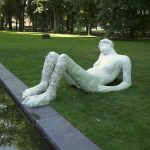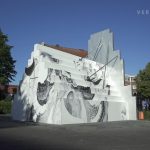Ei Arakawa (b. 1977, Fukushima) is a US queer performance artist born in Japan and based in Los Angeles since 2019. To create his exhibitions and performances, he often forms collaborations with other artists, their works, art historians, or the public. To create his current exhibition “Don’t Give Up” at Kunsthalle Friart in Fribourg (Switzerland), three living American painters (Nicole Eisenman, Laura Owens, Trevor Shimizu) and two deceased ones (Mary Cassatt, Alice Neel) have told Ei Arakawa about the difficulties of being both parents and artists. Based on that, Ei Arakawa creates a maze-like installation made of cardboard in which one encounters singing images.
Ei Arakawa: Don’t Give Up / Kunsthalle Friart Fribourg (Switzerland). Exhibition walkthrough, May 2, 2023.
> Right-click (Mac: ctrl-click) this link to download Quicktime video file.
Alternative long version (8:47 min.):
Exhibition text (excerpt):
For Don’t Give Up, three living American painters (Nicole Eisenman, Laura Owens, Trevor Shimizu) and a couple of dead ones (Mary Cassatt, Alice Neel) mentor Ei Arakawa about the hardship and reality of being a parent and an artist at the same time, a subject which is still a rare topic for female and queer artists (although Cassatt was neither married nor a parent). Arakawa’s psychic preparation for planned queer parenthood becomes a maze of hallways and rooms of cardboard in the gallery, through which the visitor encounters singing paintings. Together with the LA based composer Celia Hollander, Arakawa creates an insecure opera of “figuring this out” or “figuring paintings” in need of temporarily connected parenting artisthoods.
Ei Arakawa (*1977, Fukushima) is a queer Japan-born American performance artist based in Los Angeles since 2019. His exhibitions and performances are often created through fervent collaborations with artists (and at times their artworks), art historians, and with audience members themselves. His activities undertake the lo-fi mimicry, duplication, and embodiment of cultural forms—be they architectural structures, art historical legacies, or organizational systems—to reanimate their potentialities anew.
My Little Pumpkin(s)
Much has been written on the social reproduction of power that maintains the organizing principles of life under capitalism. As Johanna Brenner and Barbara Laslett explain : Social reproduction includes, among other things, how food, clothing, and shelter are made available for immediate consumption, how the maintenance and socialization of children is accomplished, how care is provided, and how sexuality is socially constructed. The profundity of what they grasp points us to how reproductive labor, as it plays out both domestically and institutionally, and its co- relations with gender, race and sexuality, come together to deepen our understanding of the quotidian assemblies of sociality and abstracted capital.
For scholars and other contributors to the theory of social reproduction that precede and follow Brenner and Laslett, placing emphasis on the ways in which the production of goods and services is linked to the production of life offers robust entry points in the struggle against inequality and corresponding violence, insofar as it makes appear alienated experiences and introduces sites of production. Though social reproduction itself isn’t a new concept, finding origin in Marxist tradition, we need not look that far back in time to see how it operates beyond preoccupations with class and economic value. Contemporary developments like privatization and reduction of social services, advancements in reproductive technologies, and the 2022 U.S. Supreme Court decision to overturn Roe v. Wade –including its requisite rebuke–have brought to view daily and renewed connections with the interplay of autonomy, privacy, and state sovereignty in equal measure.
Metabolizing these urgent, perennial concerns in Don’t Give Up, Ei Arakawa takes us through his complex labyrinth of emotions and reflections–reified as a cardboard maze–as he prepares for life as an artist-parent. He draws our attention to the attendant anxieties and speculations of parenthood at every turn. Simultaneously tender and chilling, the exhibition is soundtracked by an omnidirectional chorus of synthesized phrases created using vocaloids with the help of composer Celia Hollander. The lyrics are culled from conversations with artist friends and appear as written text on the surface of the cardboard walls. Arakawa elaborately maps his fractured autofiction, deploying his noted collaborative approach to further lay bare the various negotiations made as a result of the co-constitutions of social relations instigated by reproductive labor.
Located somewhere between realism and speculative fiction, performance and installation, Arakawa’s vertiginous exhibition, in all its formal dissonances, takes semiotic and pictorial references from painters including Mary Cassatt, Laura Owens, Trevor Shimizu, and Nicole Eisenman, all of whom are recognized for their idiosyncratic brush stroke technique. Here, each artist becomes an affectionate teacher. Arakawa seemingly invokes the adage “it takes a village to raise a child” in his LED reworking of their respective paintings that articulate the affective pleasures of childcare as well as intimate bond of mother and child.
These pointillist renderings in Arakawa’s corrugated theater offer a materialist perspective on the very peripheral experiences that lay claim to the reproduction of the social relations of capitalism, and thereby production of meaning and value; positions and interactions that work within and well beyond the walls of any gallery or museum. For in the same way art requires a public, so does capitalism require reproductive labor to replenish and safeguard its tenacious logics. What we bear witness to is the creative and psychic excesses of an artist grappling with these pressing tensions with the help of colleagues – alive and deceased.
Conditions that would have otherwise seemed mutually prohibitive–queer, immigrant, working artist seeking to have a baby and start a family outside of traditional protocols–further showcase what scholar Susan Ferguson states is the necessary yet contradictory social labors that renew and resist the diffuse workings of patriarchal and capitalist dynamics. It’s this sincere dialectic that remains palpable in Arakawa’s performative installation. He isn’t so much concerned with just describing his lived experience-or simply presenting childcare as a theme-but also generously tasks himself with explaining–however tersely–the differentiated parts of a particularly queer sociality. In so doing, he extends the salient question author Sophie Lewis provocatively ponders in her book Full Surrogacy Now : Feminism Against Family ( 2019 ) : Is it easier to imagine life without capitalism than it is to imagine life without the family?
For Canadian-American artist and writer Shulamith Firestone, abolishing the nuclear family system and vaginal childbirth is central to combatting the oppression and exploitation of women and children specifically. As instrumental as her argument–proposed in her book The Dialectic of Sex: The Case for A Feminist Revolution (1970)–may be, its prescriptive points of determinations present a problematic that weakens material potentials. From what neoliberalism has demonstrated, organization of power is variegated and the processes that govern its operation are not easily legible or reducible. Yet, it’s precisely the location and centering of the production of life as an essential locus in the networked production of values and meaning that substantiates Arakawa’s revelation that there are probably a “thousand million ways to raise a child”.
Now that we have technologies that ostensibly make childbirth less, in the words of Firestone, “barbaric” and “like shitting a pumpkin”, further frictions and conditions of possibilities become apparent that force us to re- evaluate the constituencies of alienated labor and being. As Ei annotates with Don’t Give Up, there are a multitude of proverbial pumpkins yet to shit out–albeit with different metabolites and consistencies. His playfully staged operatic études proffer a non-reductive lens into a charged interiority, platforming capacious discussions that take place against the backdrop of ecological and economic precarity.
Mark Pieterson
Writer, curator and public administrator living in Los Angeles





